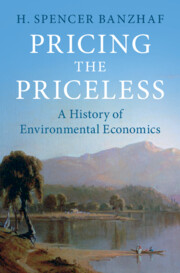201 results
Influence of Suspended Kaolinite on the Channel Form of a Polluted Stream in Cornwall
-
- Journal:
- Clays and Clay Minerals / Volume 28 / Issue 2 / April 1980
- Published online by Cambridge University Press:
- 01 July 2024, pp. 157-159
-
- Article
- Export citation
7 - The Wages of Construction
- from Part III - Sustaining Miracles, 1973–1989
-
- Book:
- Ruins to Riches
- Published online:
- 12 April 2024
- Print publication:
- 09 May 2024, pp 137-155
-
- Chapter
- Export citation
Talc in the Suspended Matter of the Northwestern Atlantic
-
- Journal:
- Clays and Clay Minerals / Volume 31 / Issue 1 / February 1983
- Published online by Cambridge University Press:
- 02 April 2024, pp. 60-64
-
- Article
- Export citation
Vapor-Phase Sorption and Polymerization of Phenols by Smectite in Air and Nitrogen
-
- Journal:
- Clays and Clay Minerals / Volume 33 / Issue 2 / April 1985
- Published online by Cambridge University Press:
- 02 April 2024, pp. 123-127
-
- Article
- Export citation
With or without the European Union: the convention for the protection of the Black Sea against pollution
-
- Journal:
- Environment and Development Economics , First View
- Published online by Cambridge University Press:
- 21 March 2024, pp. 1-23
-
- Article
- Export citation
17 - Planetary Health
- from Part 2 - Contexts for Public Health Practice
-
-
- Book:
- Essential Public Health
- Published online:
- 01 December 2023
- Print publication:
- 14 December 2023, pp 323-338
-
- Chapter
- Export citation
9 - The Pacific Context of Japan’s Environmental History
- from PART II - Economy, Environment, and Technology
-
-
- Book:
- The New Cambridge History of Japan
- Published online:
- 15 January 2024
- Print publication:
- 23 November 2023, pp 296-341
-
- Chapter
- Export citation
7 - Environmental Contamination, PCBs, and Climate Change as Public Nuisance Harms
-
- Book:
- Public Nuisance
- Published online:
- 02 November 2023
- Print publication:
- 16 November 2023, pp 131-154
-
- Chapter
- Export citation
5 - Reframing the Social, Rethinking the Body, Confronting Biologism
- from Part One - Openings and Orientations
-
-
- Book:
- The Cambridge Handbook for the Anthropology of Gender and Sexuality
- Published online:
- 29 September 2023
- Print publication:
- 19 October 2023, pp 126-152
-
- Chapter
- Export citation

Pricing the Priceless
- A History of Environmental Economics
-
- Published online:
- 19 October 2023
- Print publication:
- 02 November 2023
Analysis of a 131-year longitudinal dataset of the Eurasian otter Lutra lutra in Hong Kong: implications for conservation
-
- Article
-
- You have access
- Open access
- HTML
- Export citation
Chapter 7 - The Green 1890s:
-
-
- Book:
- Nineteenth-Century Literature in Transition: The 1890s
- Published online:
- 17 August 2023
- Print publication:
- 07 September 2023, pp 132-169
-
- Chapter
- Export citation
Chapter 8 - Asthma
-
-
- Book:
- Urban Emergency Medicine
- Published online:
- 20 July 2023
- Print publication:
- 03 August 2023, pp 98-109
-
- Chapter
- Export citation
The influence of buoyancy upon pollution trapping and dispersal in the wake of a backward-facing step
-
- Journal:
- Flow: Applications of Fluid Mechanics / Volume 3 / 2023
- Published online by Cambridge University Press:
- 18 July 2023, E21
-
- Article
-
- You have access
- Open access
- HTML
- Export citation
Air quality and mental health: evidence, challenges and future directions
-
- Journal:
- BJPsych Open / Volume 9 / Issue 4 / July 2023
- Published online by Cambridge University Press:
- 05 July 2023, e120
-
- Article
-
- You have access
- Open access
- HTML
- Export citation
3 - The Corporations and Human Rights Database
-
- Book:
- Seeking Justice
- Published online:
- 09 June 2023
- Print publication:
- 15 June 2023, pp 47-67
-
- Chapter
- Export citation
2 - Varieties of Remedy
-
- Book:
- Seeking Justice
- Published online:
- 09 June 2023
- Print publication:
- 15 June 2023, pp 25-46
-
- Chapter
- Export citation
18 - Ritual
- from Part III - Media and Modes of Ethical Practice
-
-
- Book:
- The Cambridge Handbook for the Anthropology of Ethics
- Published online:
- 11 May 2023
- Print publication:
- 25 May 2023, pp 460-484
-
- Chapter
- Export citation
5 - Aquatic Systems under Stress, c. 1000–1350
-
- Book:
- The Catch
- Published online:
- 11 May 2023
- Print publication:
- 25 May 2023, pp 183-230
-
- Chapter
- Export citation
Monitoring to conservation: The science–policy nexus of plastics and seabirds
-
- Journal:
- Cambridge Prisms: Plastics / Volume 1 / 2023
- Published online by Cambridge University Press:
- 08 May 2023, e3
-
- Article
-
- You have access
- Open access
- HTML
- Export citation












